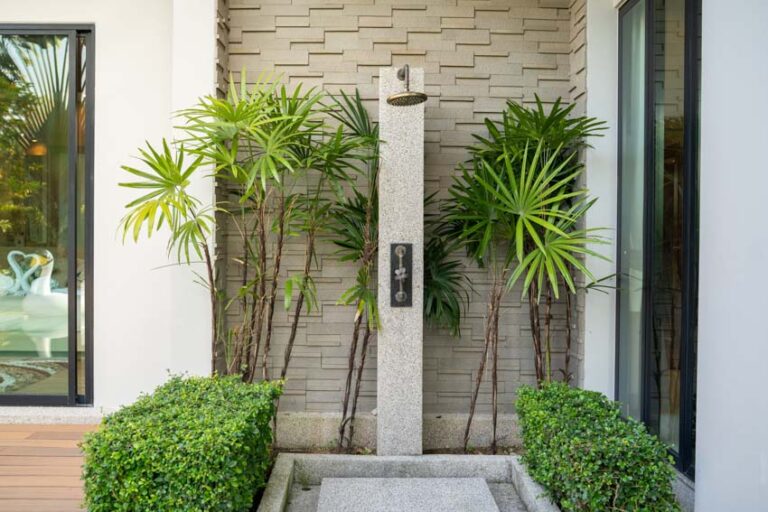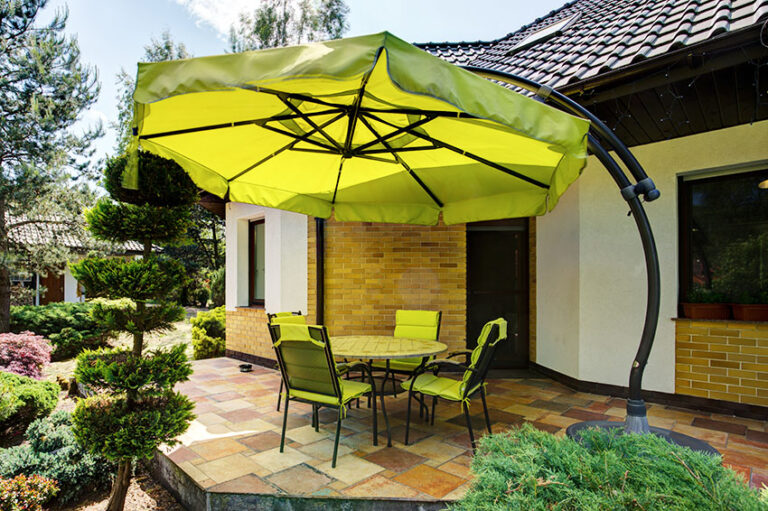7 Invisible Fence Alternatives for Dogs
Invisible fences are often used to help keep pets like dogs in your yard. However, these often work on an electric zap to keep your dog in your yard rather than a physical, visible barrier. As such, they’ve garnered quite a lot of controversy over the years.

Not to mention, they don’t offer much protection if you’re worried about someone or something entering your yard and bothering your dog. Luckily, there are plenty of alternatives to help keep your furry friends safe in your yard.
Wood Or Metal Fencing
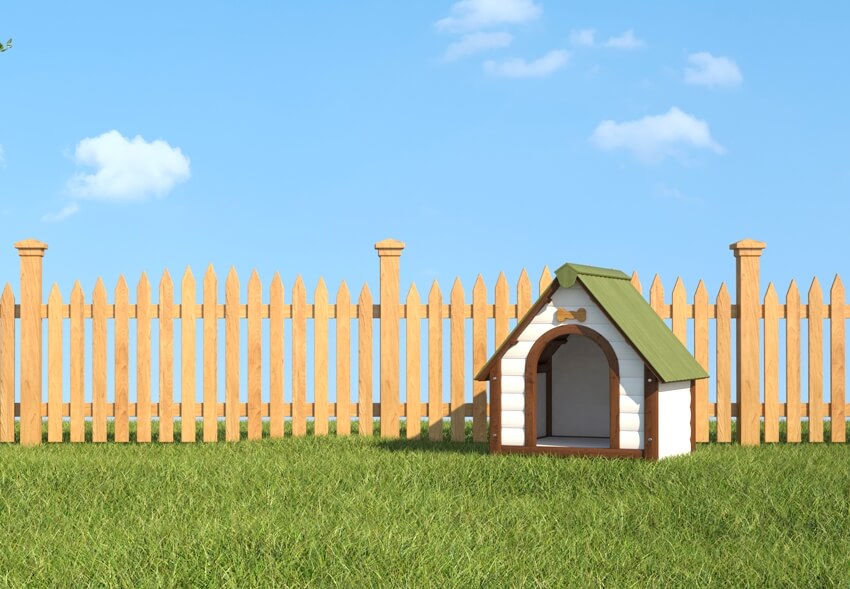
Physical fencing is the most obvious alternative to an invisible fence. These are often more expensive and more obtrusive but come in a variety of materials and designs to fit your landscape well. Two common materials for fencing are wood and metal.
Wood is a classic choice but comes in many modern iterations as well. It’s a popular choice for its appearance which can vary with the type of wood you choose as well as the design. However, wood fences do tend to struggle with the weather, depending on the climate you live in. See our guide to the best wood for fences here.
Concepts like humidity and heat can cause a wooden fence to warp or even rot if it isn’t properly maintained. This includes steps such as regularly sealing the wood but this can vary depending on the type of wood you choose.

Metal fences also come in a few different forms such as wrought iron, aluminum, and steel fences. This can be more costly than wood fencing but it comes with some additional durability compared to wood.
It also isn’t as prone to warping. Much like wood, though, it comes in a variety of styles and designs. Unfortunately, if you’re looking for a privacy fence, metal fencing won’t work very well.
Pet Playgrounds
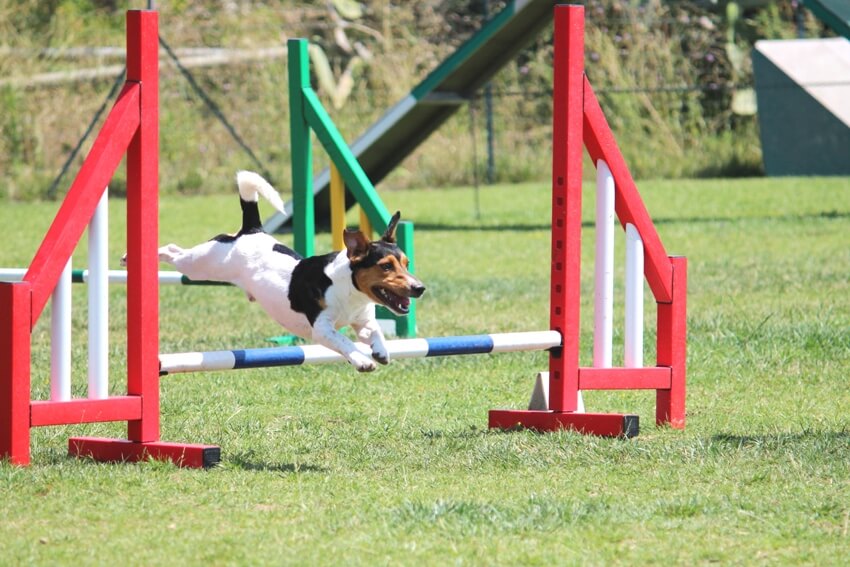
Another option is to take your pets to a pet playground like a dog park for some time in the sun. This usually gives them space to run off leash and spend time outside much as they would in a yard.
Another huge benefit to pet playgrounds is that since they’re often public by nature, they’re usually free to go to. This also means you’ll likely share the park with other dogs.
This gives your dog the chance to socialize and spend time with other dogs. On the other hand, this can cause a problem if you have a shy or aggressive dog who doesn’t particularly enjoy the company of others.
The biggest downside to a dog park is that, unlike a fence, it isn’t right in your yard. This means you can’t just let them outside when your dogs ask to go out. Rather, you’ll have to travel a bit, even if you live near a dog park.
Some pet owners find that this doesn’t satisfy the entire reason they want an enclosed space for their pets right in their own backyards. After all, you won’t be able to let your dog out when they’re asking and that’s a big part of the reason many pet owners would want an alternative to an option like invisible fencing.
Polypropylene Plastic Mesh Fence

Polypropylene plastic mesh fences are a lightweight option to create a perimeter around your yard. This material looks like plastic netting and has a grid-like appearance.
Because it’s so lightweight, polypropylene plastic mesh fencing is easy to move and set up. This makes it a popular choice for gardens but you can use it around the perimeter of your yard to keep pets in place. Despite its easy-to-set-up fashion and movable design, this fencing can last quite a while. Barring any major damage, you can use it for up to 20 years or even longer!
Another benefit to polypropylene plastic mesh fences is that they’re made out of relatively inexpensive materials, making the whole fence a cost-friendly option. The nature of the fence is easy to put up yourself without hiring professional help.
The biggest downside to this type of fencing is that it’s not going to handle a lot of weight against it before it collapses. For small dog breeds, this isn’t likely to become much of a problem.
On the other hand, if you have a larger dog breed, you may find that polypropylene plastic mesh fencing isn’t quite strong enough to keep them from leaving if they ran at the fence or jumped against it.
Smaller-Zone Fencing

It’s worth noting that when you have fencing, it doesn’t necessarily have to go around the perimeter of your yard. Smaller-zone fencing refers to fencing in smaller areas of your yard rather than the whole thing. You can do this with any type of fencing.
This is a great option when you have a dog that needs less space to run around. A smaller breed, for instance, may do fine in part of the yard even though a larger breed may need more space to roam. Smaller-zone fencing within larger fencing can also be used to keep your dogs out of certain areas of your yard like a garden or pool.
Long Line Dog Tie-Outs
Some dog owners prefer to rely on a long line dog tie-out to keep their pet in their yard but still give them plenty of space to roam. This comes with an obvious cost benefit upfront. Unlike an option like physical fencing, you don’t have to pay to purchase and install an entire fence.
For you and your dog, it comes with the security of knowing your dog won’t leave your yard. They won’t have quite as much space to run freely as when they’re unleashed in a fenced-in area but long lines offer a lot of freedom of movement. As with on a walk, leashes do also offer additional control for pet owners.
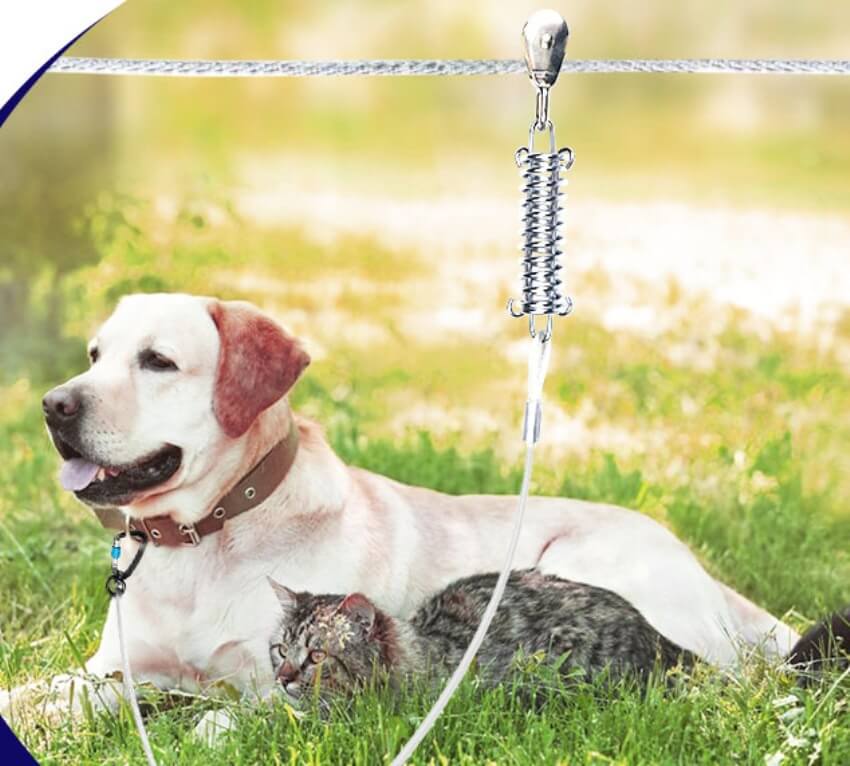
However, there are some drawbacks, and not every leash will work for every dog. Less leash-trained dogs may not take to a tie-out system right away compared to running freely in a fenced-in area.
If you aren’t careful or if your pet does something unpredictable, it can cause injury if you get wrapped up in the lead while you’re outside with your dog. Yet, some owners find the added control a leash offers can help with training as well.
Trolley & Zip-Line System
A trolley & zip-line system for your dog is actually really similar to a tie-out leash in concept. Instead of fixing the leash to one point, though, the leash is clipped to a fixed line that the dog can pull the leash along.
For example, some dog owners use a clothesline in their yard as an anchor point for a trolley & zip-line system for dogs. On the other hand, you can create a zip-line with any stagnant, horizontal cord.
A zip-line is handy compared to a tie-out option because it’s a lot less likely to get tangled. Not to mention, it gives your pet a lot more room to run around since they have the added movement where their leash moves along the zip-line. This additional give can help your pets further avoid the unfortunate circumstance of running out to the end of their line too fast.
It’s best to keep a close eye on your pet using a zip-line, though. If they get tangled and can’t get out, it can cause them a lot of trouble. Much like a tie-out line, you’ll need to pay attention to the weather too.
A zip-line will keep your dogs from just running to the door if the weather gets to be too much for them, so make extra sure they’re comfortable outside each time. Neither of these options will keep people or other animals out of your yard either.
Behavioral Training

Many pet owners rely on options like invisible fencing and shock collars for behavioral training but there are other ways to go about it. With the right, compassionate training, you can teach your dog to stay in your yard.
The exact technique you use can vary but a lot of experts recommend starting by taking your dog into your yard on a leash. Once they’ve got that down, you can start to slowly and in small doses set the leash down, giving them the option for freedom.
Then, you can run through some simple commands to teach them to stay in the yard. Instead of a painful shock for disobeying, the goal here is to reward them for obedience.
Of course, training isn’t a perfect process by any means and there might be mistakes along the way. This means there is some risk involved when you’re teaching your dog not to run away. You can help this process by committing to training your dog to come at your call. This is commonly referred to as recall training.
All in all, invisible fencing is far from your only choice when it comes to keeping your pets safe and sound. From physical fencing to leashes and even a trip to the dog park, there are plenty of ways to keep your pets out of harm’s way.
See more related content in our article about artificial turf for dogs pros and cons here.


